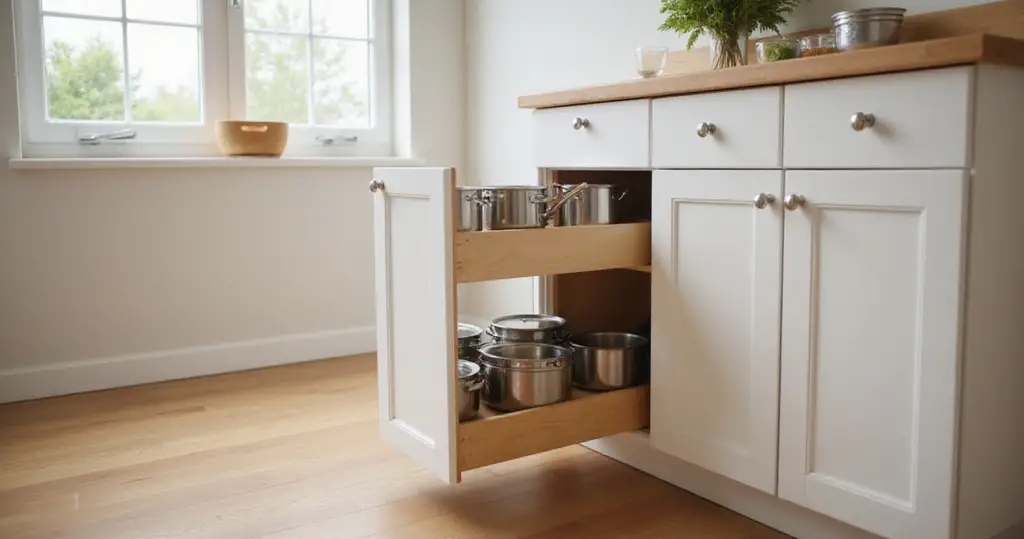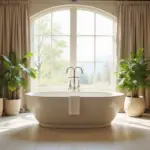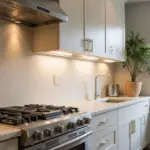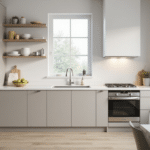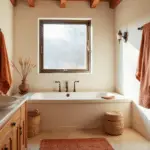Is your kitchen cabinet a chaotic jumble? Do you dread opening certain doors, knowing you’ll have to dig and search just to find one simple item? You’re not alone. Kitchen cabinets, while essential storage, can quickly become black holes where items disappear, space is wasted, and frustration mounts.
But imagine a kitchen where every item has its place, where finding what you need takes seconds, and where you’ve magically created extra storage out of thin air. This isn’t a fantasy; it’s the power of ingenious kitchen cabinet organizers. These smart solutions transform your cabinets from frustrating free-for-alls into models of efficiency.
1. Slide-Out Shelves and Drawers for Easy Access
One of the biggest frustrations with deep kitchen cabinets is the difficulty of accessing items stored at the back. You find yourself bending down, reaching in, and often pulling out items in the front just to get to something hidden in the rear. Slide-out shelves and drawers eliminate this struggle entirely.
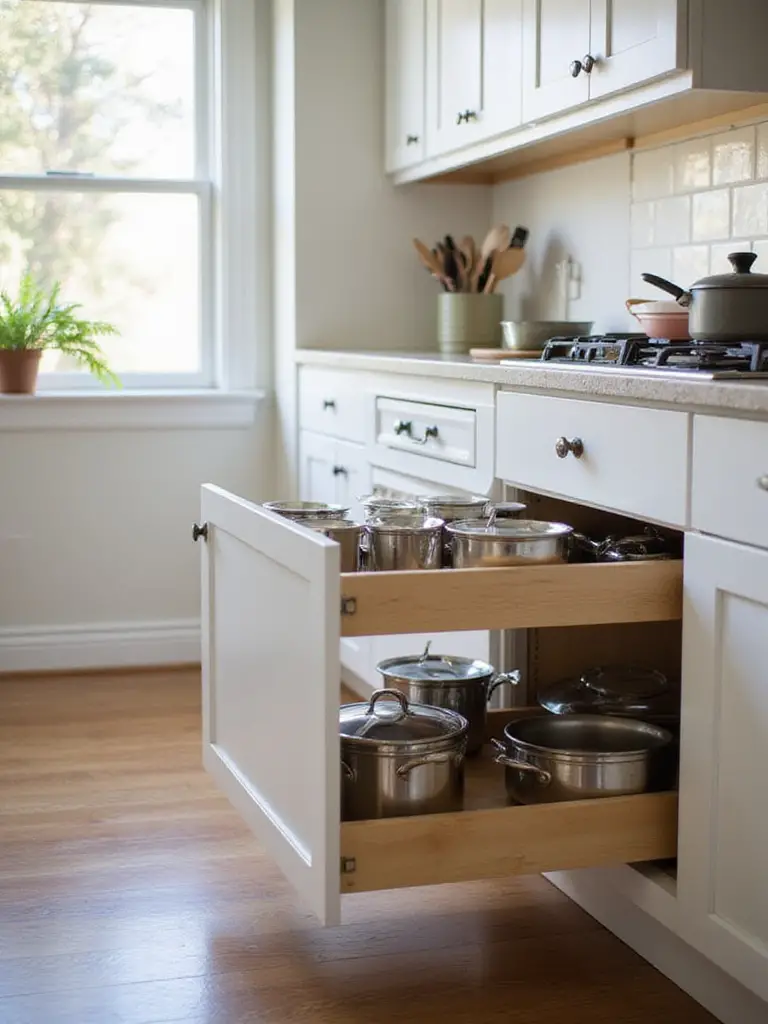
These pull-out solutions bring the entire contents of the cabinet forward, making everything visible and accessible with one simple motion. They’re particularly effective for heavy cookware, bulky appliances, or pantry staples like cans and jars. Modern versions glide smoothly on ball bearings or nylon rollers, transforming even the deepest cabinet into a functional space.
“The best kitchen designs recognize that accessibility isn’t a luxury—it’s essential for daily function. Slide-outs acknowledge the reality of how we actually move and reach.” – Amara Khoury-Jensen
The inspiration for this collection struck when I visited a client’s home in Arizona, where the heat demands efficiency in movement. There, kitchen cabinet organizers weren’t just conveniences—they were necessities that reduced time spent with open refrigerator doors or searching through hot cabinets.
2. Under-Sink Organizers to Tame Cleaning Supplies
The cabinet beneath your kitchen sink is often a chaotic zone thanks to plumbing pipes, disposal units, and water lines that break up the usable area. This irregular shape makes standard bins or shelves inefficient, leading to a jumble of cleaning supplies that get lost in the depths.
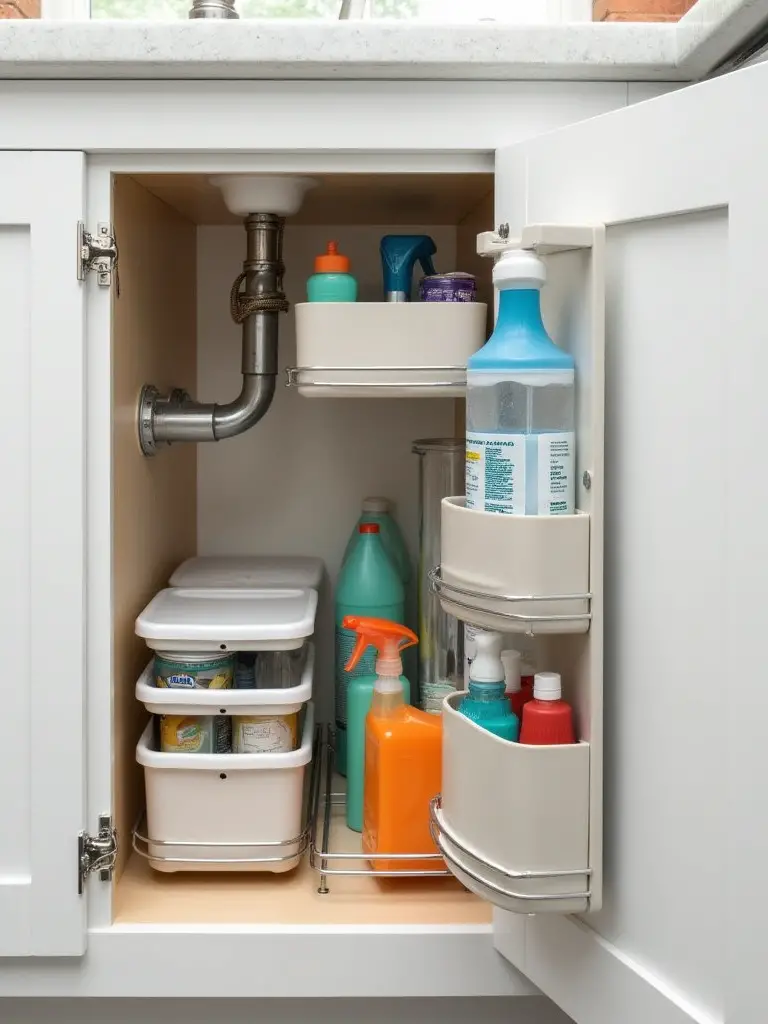
Specialized under-sink organizers work around these obstacles with U-shaped designs or adjustable shelves that accommodate pipes. Pull-out caddies bring supplies forward for easy access, while tiered shelves utilize vertical space that would otherwise go unused. Some systems even include door-mounted racks for spray bottles or sponges, maximizing every inch of this challenging space.
Look closely and you’ll notice the subtle texture of these organizers—many feature ventilated designs that allow air circulation in an area prone to moisture, preventing mildew and extending the life of both the organizer and your supplies.
3. Tiered Spice Racks for Visibility and Reach
Spice jars present a unique storage challenge—they’re small, numerous, and when lined up on a flat shelf, it’s nearly impossible to see the labels on jars at the back. This leads to wasted time searching, duplicate purchases, and general frustration during cooking.
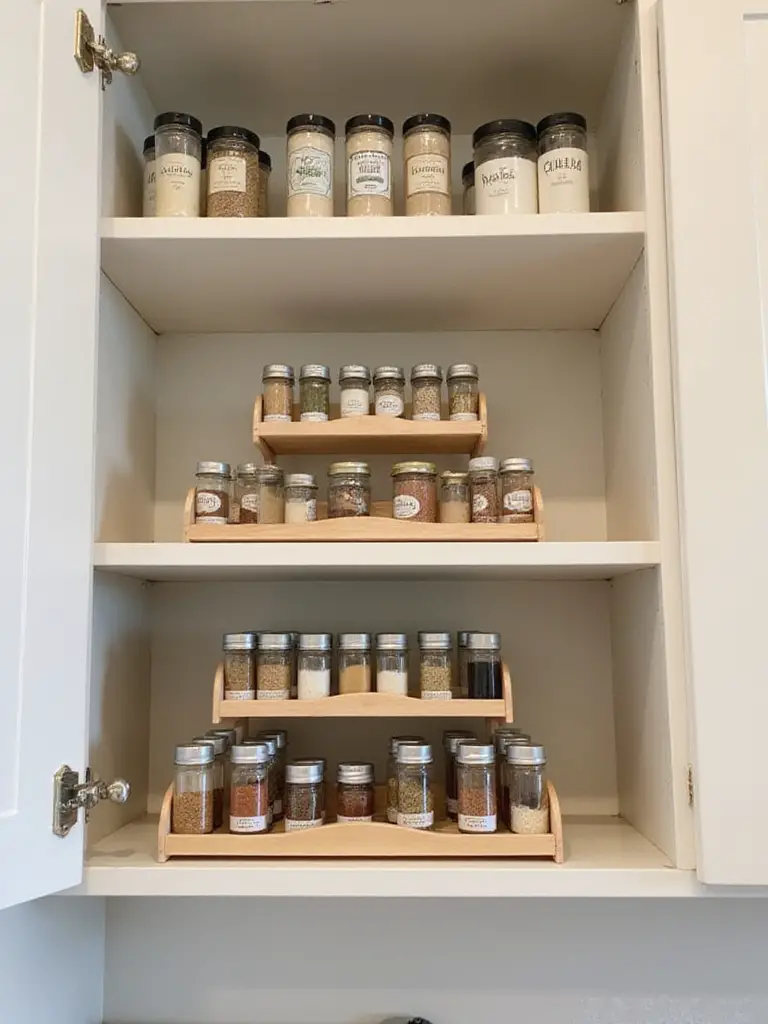
Tiered spice racks, with their step-like design, elevate back rows of spices so you can see every label at a glance. These simple but brilliant organizers come in various materials and configurations, from expandable metal racks to bamboo risers with adjustable widths. Some even include pull-out functionality, bringing your entire spice collection forward for easy selection.
- Best for: Spices, small jars, extract bottles, supplements
- Materials: Bamboo, metal, plastic, acrylic
- Installation: No tools required for most models
The magic of this piece lies in its ability to transform not just organization but your cooking experience itself. When every ingredient is visible and accessible, cooking becomes more fluid and creative—a principle I’ve observed in both traditional Middle Eastern kitchens and modern Scandinavian designs.
4. Cabinet Door Mounted Pot Lid Holders
Pot lids are notoriously awkward to store—they’re bulky, oddly shaped, and difficult to stack neatly with their corresponding pots. They take up valuable horizontal space and often create unstable stacks that collapse at the slightest touch.
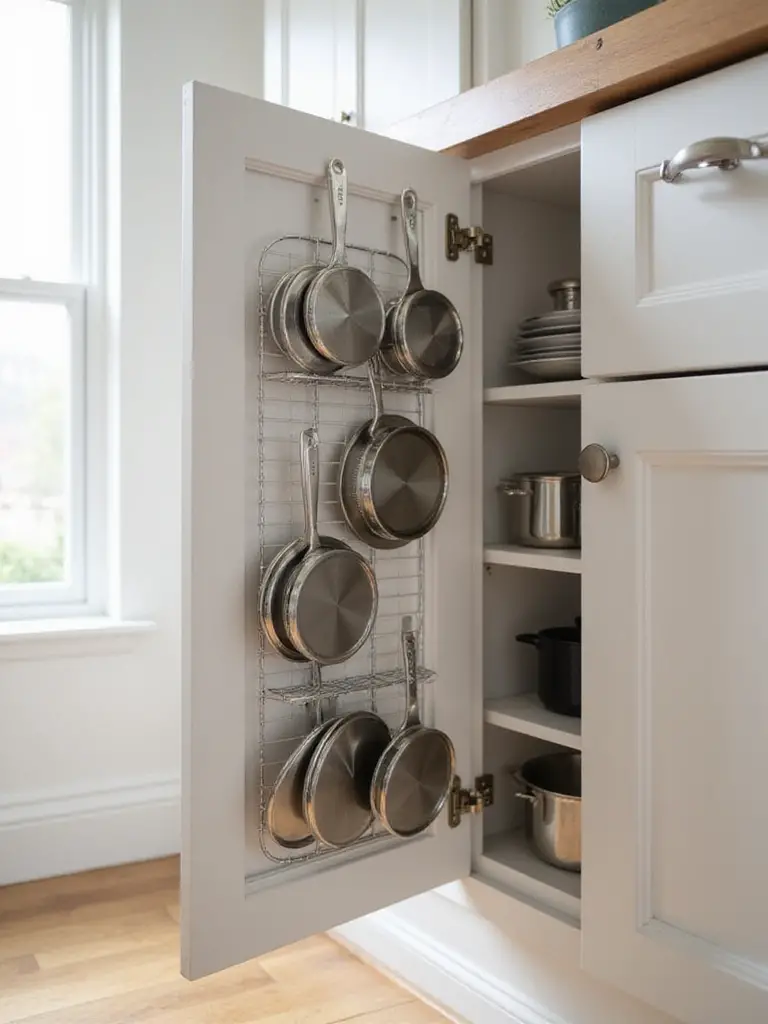
Cabinet door mounted pot lid holders utilize the often-forgotten vertical space on the inside of cabinet doors. These wire racks or plastic brackets attach to the door and hold lids securely in place, keeping them organized, visible, and readily accessible. By moving lids to the door, you free up significant shelf space for other cookware and eliminate the frustration of searching for the right lid.
What makes this design special is the way it transforms dead space into functional storage. In desert homes where space is often at a premium, these small innovations make a significant difference in kitchen workflow and efficiency.
5. Vertical Dividers for Baking Sheets and Cutting Boards
Baking sheets, cutting boards, and similar flat items are cumbersome to stack horizontally. Accessing items from the middle or bottom of the stack means removing everything on top, and the constant friction from pulling them out can damage surfaces over time.
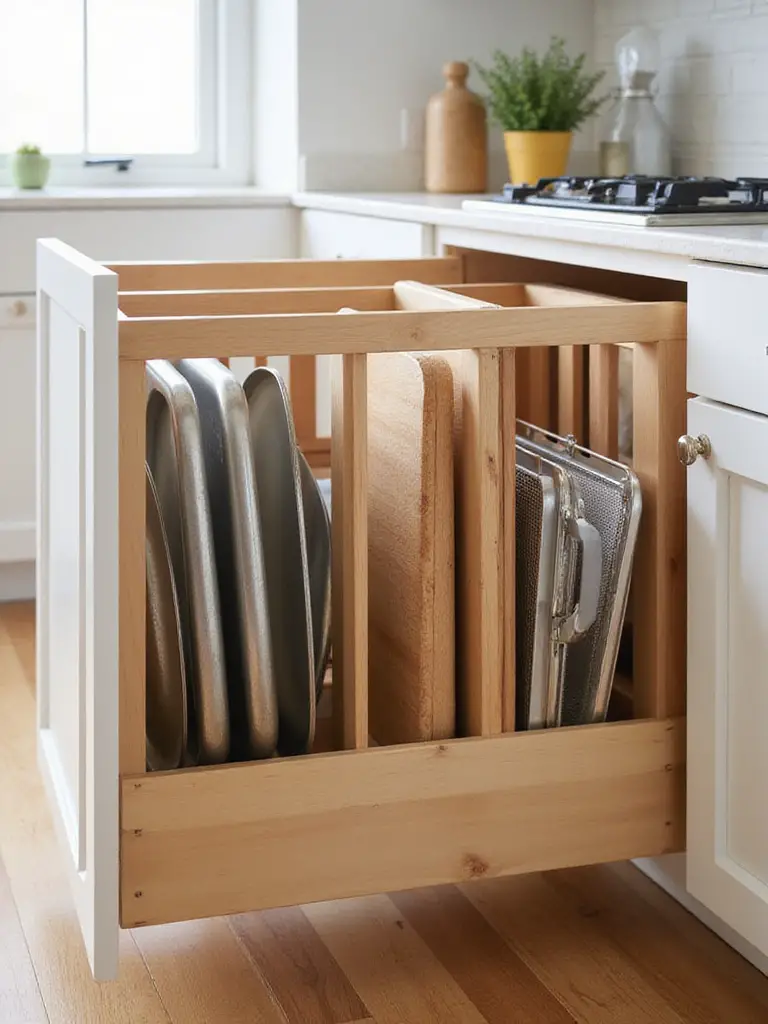
Vertical dividers create upright slots that allow these items to stand on their edges, making each one individually accessible without disturbing the others. These organizers can be installed in cabinets or deep drawers and come in various materials including wire, wood, and plastic. Some feature adjustable dividers to accommodate items of different thicknesses.
Running your hand across this material reveals the thoughtful design—smooth edges prevent scratching on your cookware, while sturdy construction supports even heavy stone cutting boards or cast iron griddles.
6. Corner Cabinet Lazy Susans for Spinning Storage
Corner cabinets often feature deep, cavernous spaces that are difficult to access, resulting in wasted space and forgotten items pushed to the back. The lazy susan, with its rotating design, transforms these problematic corners into highly functional storage.
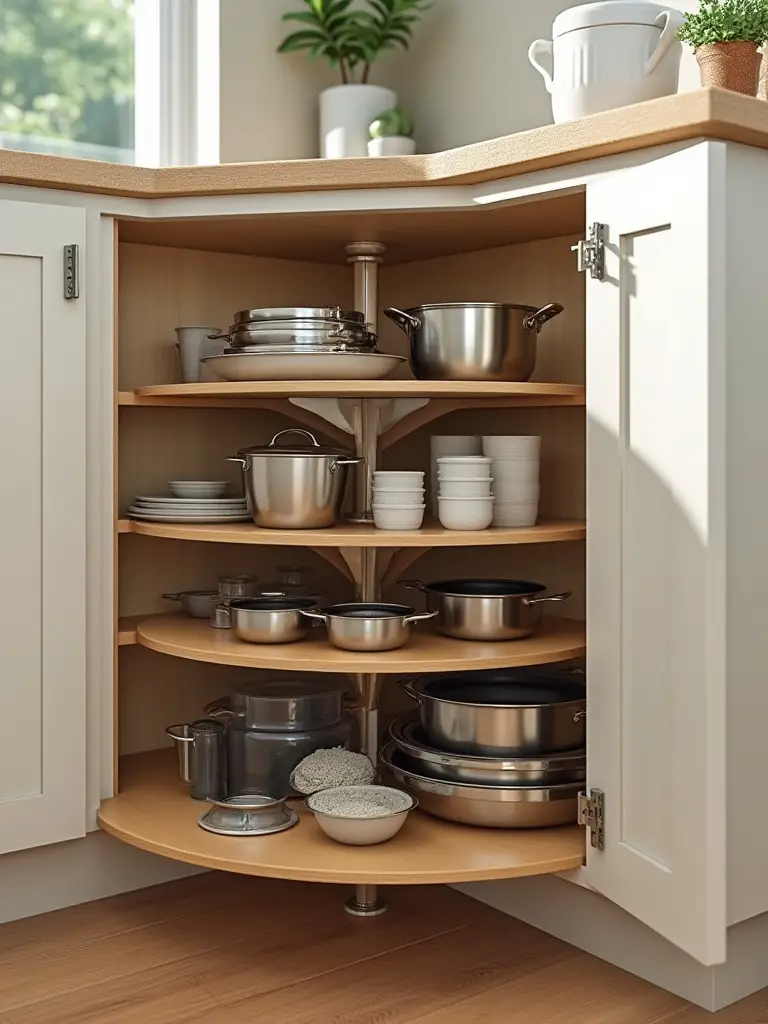
By mounting shelves on a central pole or bearings, a lazy susan allows the entire contents of the corner cabinet to rotate, bringing items from the back to the front with a simple spin. They come in various configurations to fit different corner types, including full circle for diagonal corners and kidney-shaped designs for blind corners. Modern versions feature non-slip surfaces and raised edges to prevent items from sliding off during rotation.
Unlike conventional options, this approach reduces the need to bend and reach into deep corners—a particular benefit for those with mobility limitations or in kitchens where every movement should be efficient, like those in hot desert climates where energy conservation becomes second nature.
7. Stackable Cabinet Shelves to Double Vertical Space
Many cabinet shelves have significant vertical clearance above the items stored on them, creating “dead space” that goes unused. This is especially true when storing plates, bowls, or canned goods that don’t utilize the full height between shelves.
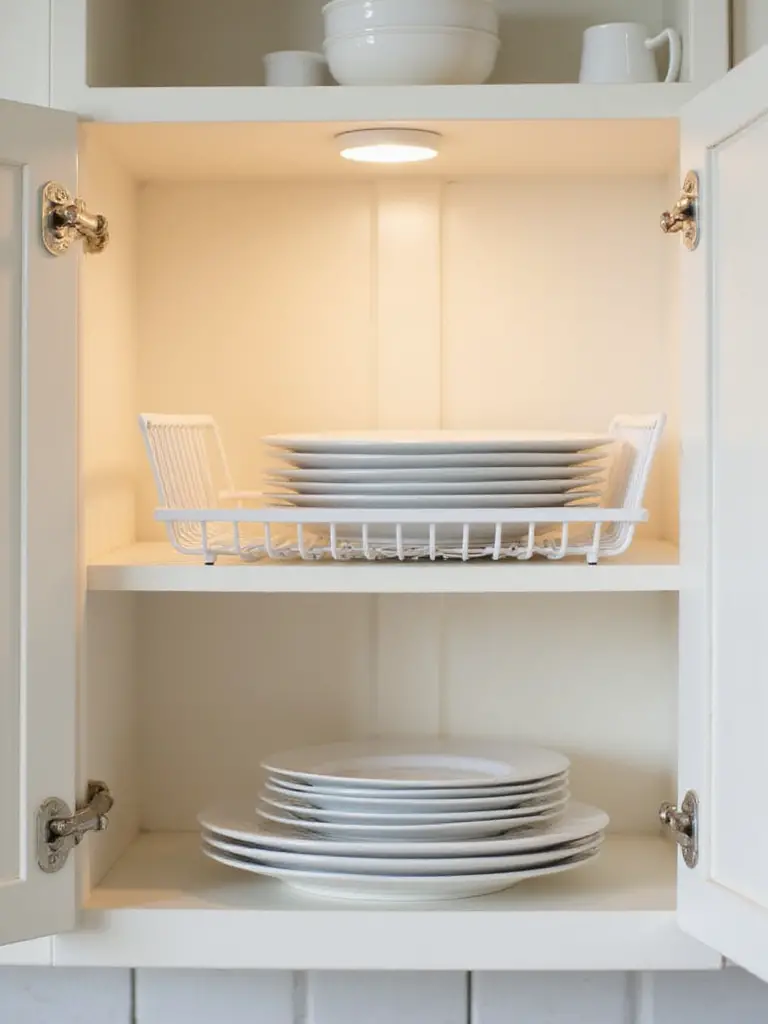
Stackable cabinet shelves are simple platforms that sit inside your cabinet, creating an additional level of storage. These U-shaped or rectangular units effectively double the usable area within that section of the cabinet, allowing you to organize items more efficiently without precarious stacking. They’re ideal for separating dinner plates from salad plates, organizing different types of bowls, or creating dedicated spaces for mugs and glasses.
The artisans behind these designs began with a fundamental question: how can we make visible what is typically hidden? The answer lies in these elegant, simple solutions that reveal the contents of your cabinets at a glance rather than concealing them in shadowy depths.
8. Drawer Dividers and Inserts for Utensils and Gadgets
Kitchen drawers filled with utensils and gadgets quickly become tangled messes where items hide beneath each other. Finding the right tool means digging through layers, wasting time and creating frustration during meal preparation.
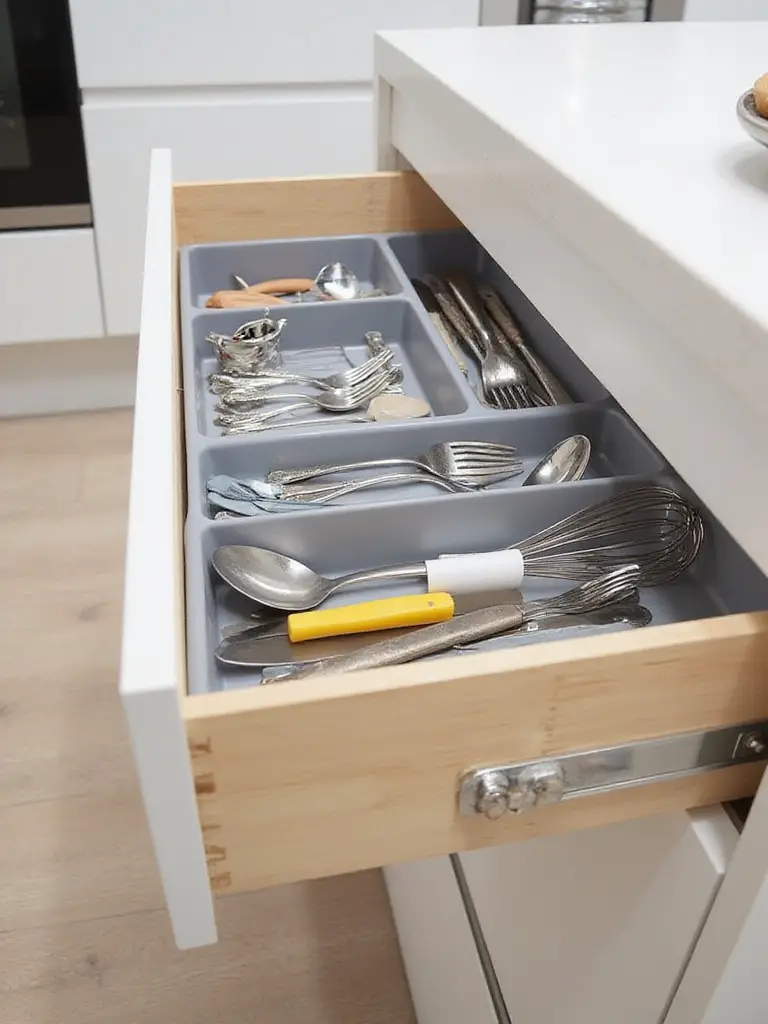
Drawer dividers and inserts bring order to this chaos by creating designated compartments for each type of utensil or gadget. They range from simple adjustable dividers to custom-fit trays with specialized slots for specific items. Beyond organization, these systems protect your tools from damage by preventing them from rubbing against each other, and they maximize space by arranging items efficiently.
- Adjustable dividers: Create custom-sized compartments
- Fixed compartment trays: Provide designated spots for common utensils
- Specialized inserts: Include knife blocks, spice organizers, or tiered systems
When clients ask us about balancing style with function, drawer organizers are often where we begin. They represent the philosophy that true desert design isn’t about aesthetics alone but about creating systems that make daily life more efficient in challenging environments.
9. Over-the-Cabinet Door Organizers for Wraps and Bags
Boxes of plastic wrap, aluminum foil, parchment paper, and food storage bags are essential kitchen items, but they take up valuable drawer space and often slide around or stack awkwardly. The back of a cabinet door offers perfect vertical storage for these items.
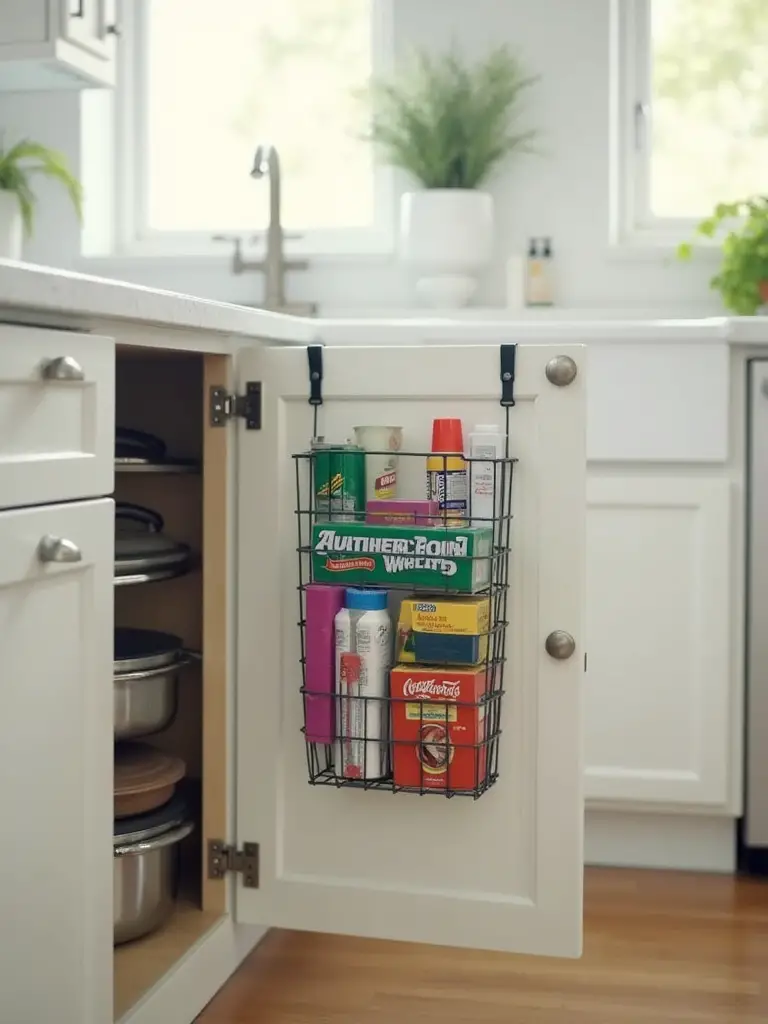
Over-the-cabinet door organizers feature wire or plastic racks that hang directly over the top edge of a standard cabinet door, requiring no installation or drilling. With slots sized specifically for wrap boxes, these organizers keep these items vertical, visible, and easily accessible. They’re particularly valuable for renters who need non-permanent storage solutions or anyone looking to maximize every inch of cabinet space.
The silhouette draws inspiration from traditional Middle Eastern storage systems, where vertical organization has long been valued in compact living spaces. This approach acknowledges that modern kitchens must accommodate a growing array of tools and supplies while maintaining order and accessibility.
10. Pull-Out Trash and Recycling Bins
Freestanding trash cans and recycling bins consume valuable floor space, disrupt kitchen flow, and create visual clutter. Integrating waste management into your cabinetry creates a cleaner, more streamlined kitchen environment.
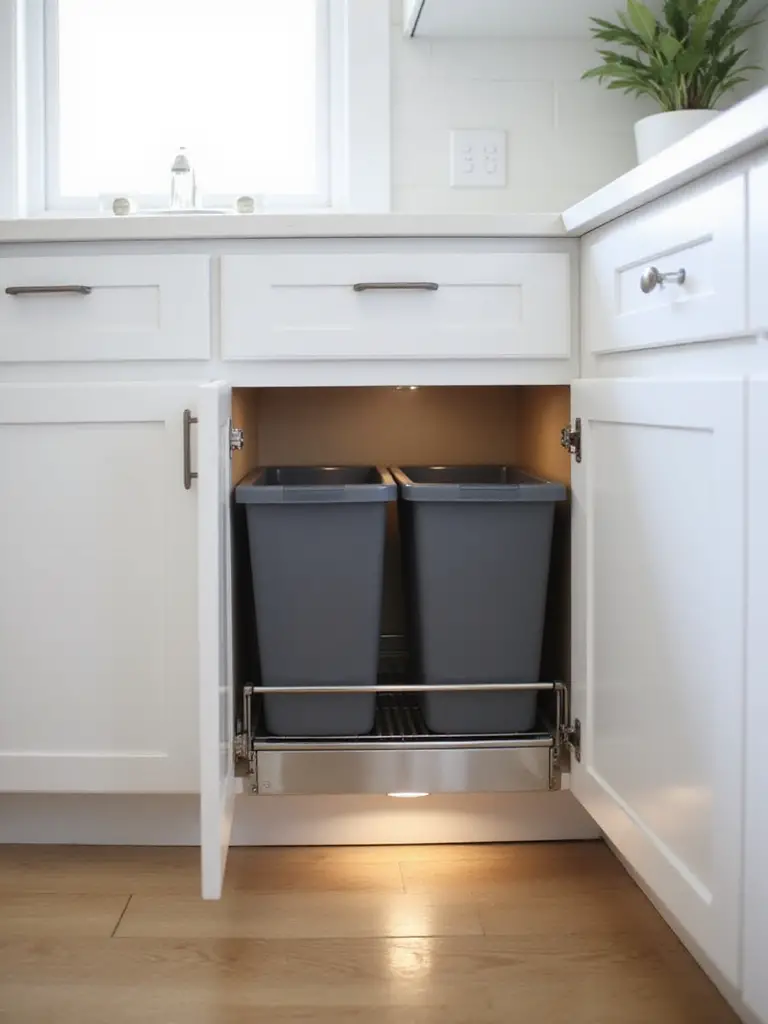
Pull-out trash and recycling systems fit inside standard base cabinets, typically featuring smooth-gliding tracks that allow bins to extend fully for easy access. Available in single, double, or even triple configurations, these systems can accommodate separate bins for trash, recycling, and compost. Some models attach to the cabinet door, so the bin extends automatically when the door opens, while others feature soft-close mechanisms for quiet operation.
Beyond aesthetics, the ecological impact matters because integrated waste systems make sorting easier, encouraging recycling and composting. These kitchen cabinet organizers reflect a growing awareness that sustainable practices should be built into our daily environments, not added as afterthoughts.
11. Plate Racks and Stackers for Dishware
Storing plates and bowls often means creating tall, unstable stacks that make accessing items at the bottom difficult and increase the risk of chips and scratches. Plate racks and stackers bring order to dishware storage while protecting your valuable pieces.
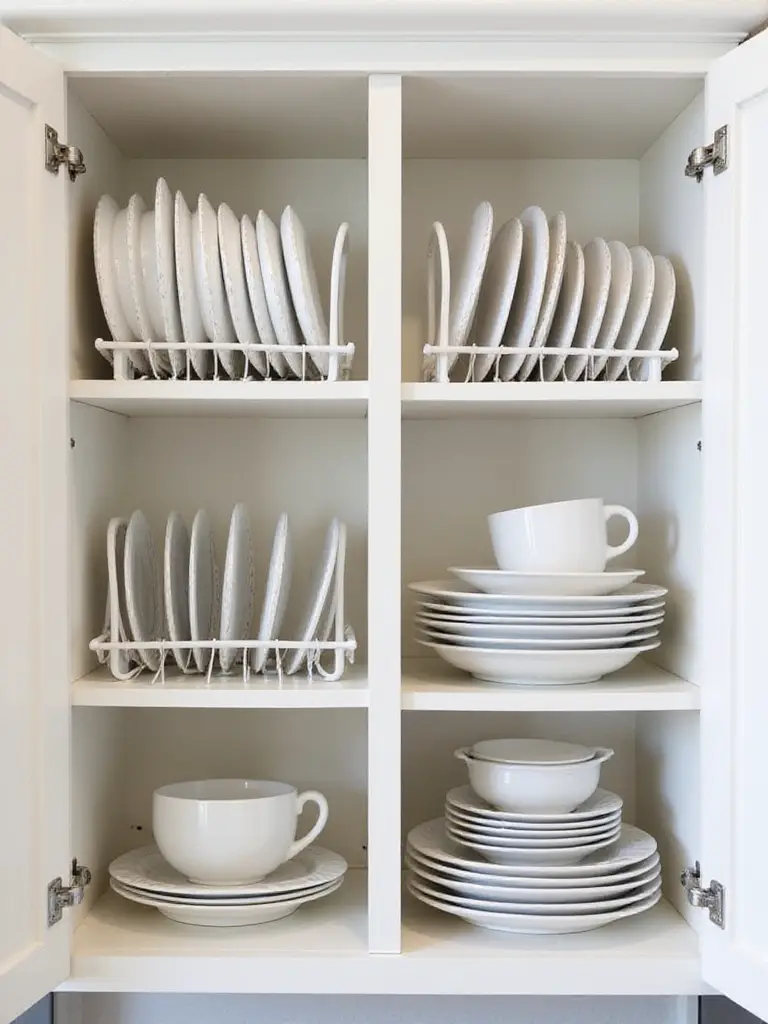
Vertical plate racks store plates on their edges with dividers between each one, allowing you to remove any plate without disturbing the others. Horizontal stackers create multiple layers within a cabinet shelf, preventing direct stacking while maximizing vertical space. Both types improve accessibility and protect dishware from damage caused by stacking or shifting. They’re available in wire, bamboo, wood, or plastic to match your kitchen aesthetic.
For those worried about maintenance, these organizers typically require minimal care—most can be wiped clean with a damp cloth, and many are dishwasher-safe for occasional deep cleaning.
12. Under-Shelf Hooks for Mugs and Cups
Mugs and cups can consume surprising amounts of cabinet space, especially if stacked insecurely or stored in single rows. Under-shelf hooks utilize the empty vertical space directly below a cabinet shelf, effectively doubling storage capacity.
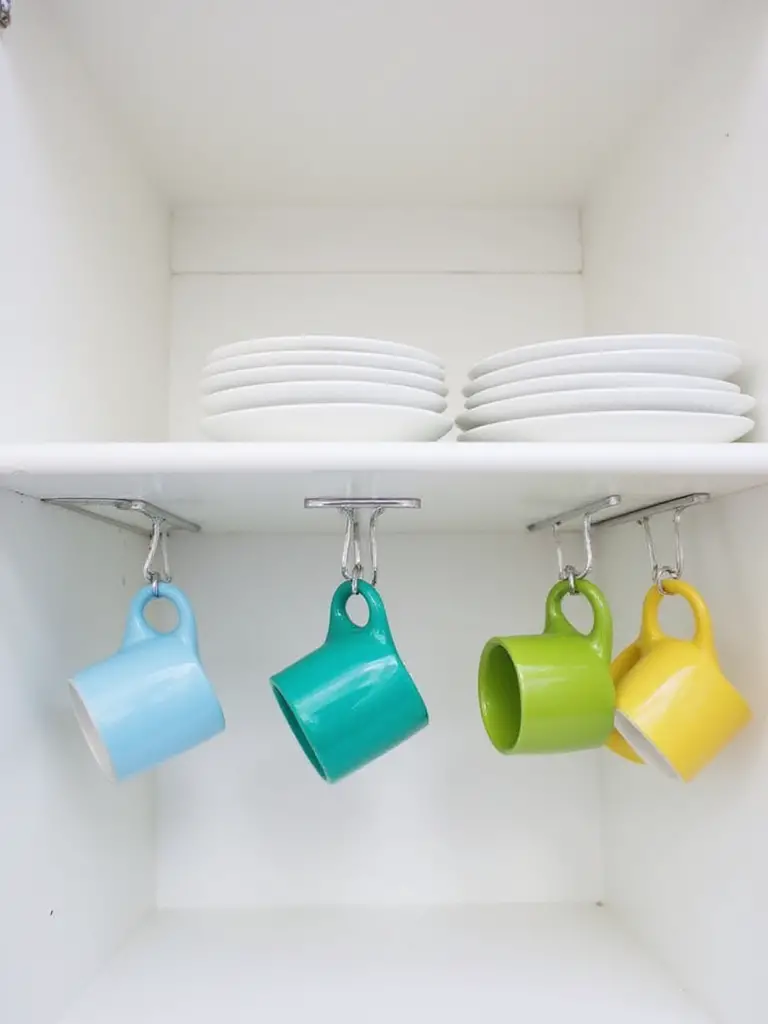
These simple organizers feature brackets that slide onto the front edge of an existing shelf, with hooks extending downward to hold mugs by their handles. The installation requires no tools or permanent modifications, making them ideal for renters or those who prefer flexible storage solutions. Beyond mugs, these hooks can also hold measuring cups, small utensils with hanging loops, or even lightweight cooking tools.
The interplay between the colors of your mugs and the negative space created by this hanging system transforms a simple storage solution into a display opportunity—something I’ve incorporated into designs ranging from minimalist Scandinavian kitchens to vibrant Mediterranean-inspired spaces.
13. Pull-Out Caddies for Under-Sink Organization
The under-sink area presents unique challenges with its pipes, disposal unit, and often limited accessibility. Reaching into the back of this cabinet is awkward and inefficient, leading to wasted space and forgotten supplies.
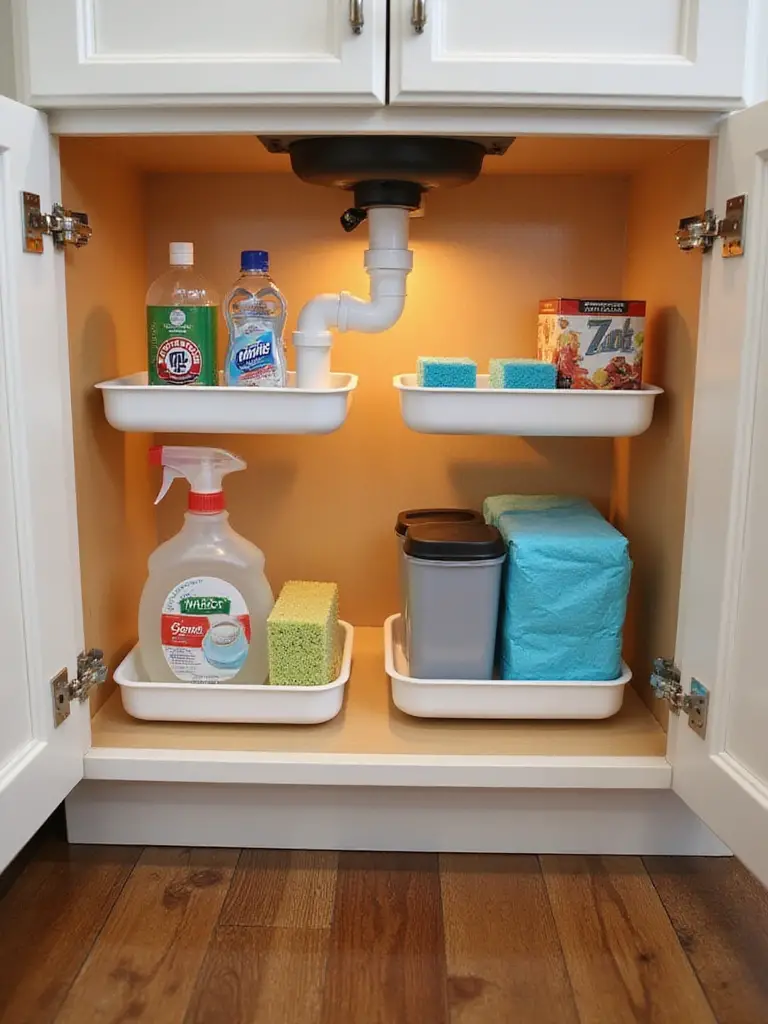
Pull-out caddies designed specifically for under-sink use feature cutouts or L-shapes to navigate around plumbing obstacles. These sliding shelves bring the entire contents forward when pulled out, putting everything within easy reach. Made from materials like chrome-plated metal, stainless steel, or durable plastic, they’re designed to withstand the potentially damp environment under the sink while providing years of smooth operation.
The versatility reveals itself when you pair this with complementary storage solutions like door-mounted racks or stackable bins, creating a comprehensive system that utilizes every inch of this challenging space.
14. Can Dispensers and Stackers
Canned goods stored on flat shelves can be difficult to see and access, especially those at the back. They’re also prone to toppling over when stacked or when one is removed from the middle of a row.
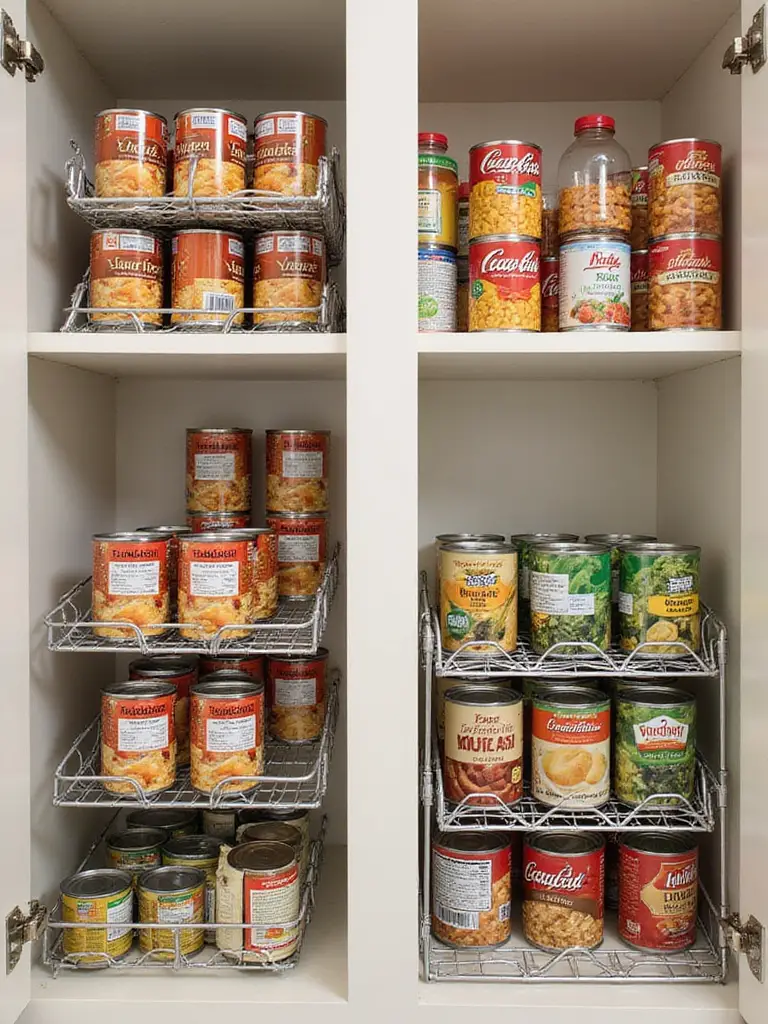
Can dispensers and stackers bring order to your canned goods collection with two main approaches: gravity-fed dispensers that roll cans from back to front as they’re removed, and stackable racks that create multiple layers for different types of cans. Both improve visibility, accessibility, and inventory management by allowing you to see what you have at a glance. They’re particularly valuable in pantries or deep cabinets where items at the back often go forgotten.
The environmental story behind these pieces began with observations of commercial kitchen storage, where efficiency isn’t just convenient—it’s essential. By adapting these principles to home kitchens, these organizers promote better food management and less waste.
15. Bakeware Organizers for Muffin Tins and Cooling Racks
Bakeware items like muffin tins, cooling racks, and baking sheets are notoriously difficult to store due to their flat, thin profiles. Stacking them horizontally creates instability and makes retrieving a specific item challenging.
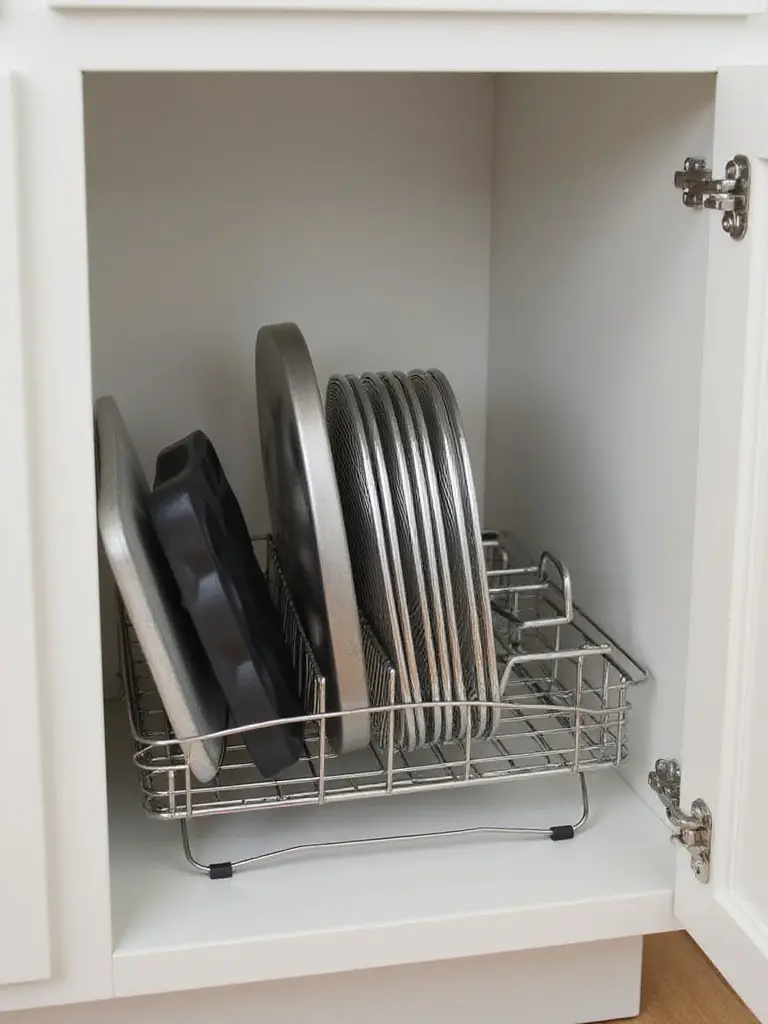
Bakeware organizers use vertical dividers to store these items on their sides, allowing you to slide out exactly what you need without disturbing the rest. These organizers can be installed in cabinets or deep drawers, with adjustable dividers to accommodate items of different sizes. Storing bakeware vertically not only improves accessibility but also prevents warping that can occur when thin metal items are stacked with weight on top.
While designed for the living room, we’ve seen creative uses in kitchens where these same organizing principles transform chaotic cabinets into functional spaces that make baking more enjoyable and spontaneous.
16. Small Appliance Pull-Out Platforms
Heavy small appliances like stand mixers and food processors are essential tools that are cumbersome to lift out of low cabinets yet take up valuable counter space if left out permanently. Small appliance pull-out platforms offer an elegant solution to this dilemma.
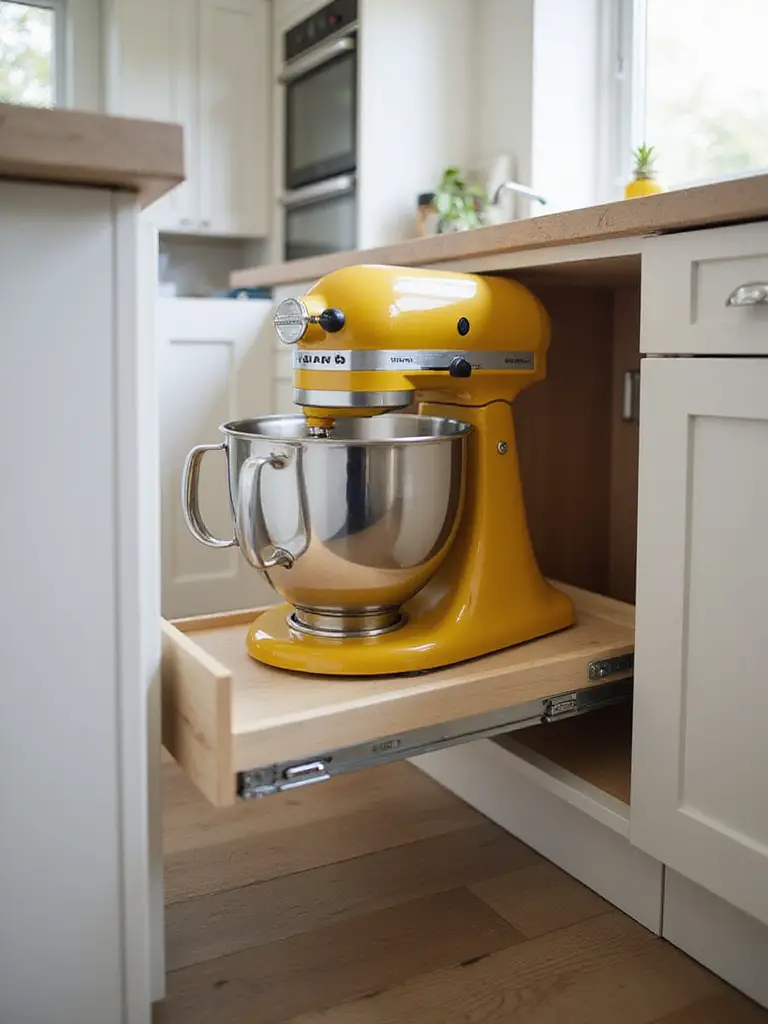
These robust sliding shelves can be installed within base cabinets to bring appliances forward on smooth glides. Advanced versions include lifting mechanisms that raise the appliance to counter height when extended, eliminating the need to lift these heavy items manually. This significantly improves accessibility and ergonomics while keeping countertops clear for food preparation. The platforms are typically designed to hold substantial weight—often 60-100 pounds or more—making them suitable even for professional-grade appliances.
The craftsmanship reveals itself in details like the smooth-operating lift mechanisms and sturdy construction that supports heavy items without wobbling or sagging—a testament to the engineering that goes into these specialized kitchen cabinet organizers.
17. Cabinet Insert Wine Racks
For wine enthusiasts who want to keep a small collection accessible in the kitchen without dedicated wine storage, cabinet insert wine racks offer an elegant solution that utilizes existing cabinet space.
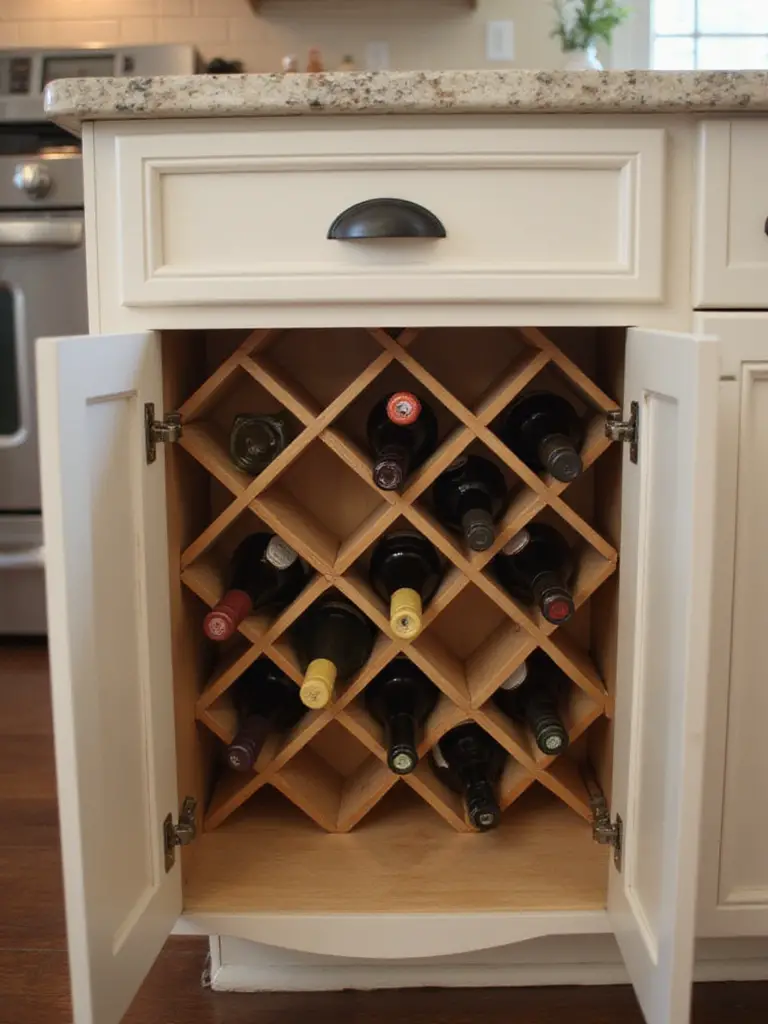
These inserts fit inside standard kitchen cabinets, with cradles designed to hold wine bottles on their sides—the proper position for storage to keep corks moist and prevent oxidation. Available in wood, metal, or wire configurations, they can be chosen to complement your cabinet style while providing proper storage for your collection. Beyond wine, these racks can also store other bottled items like specialty oils or vinegars, provided the bottles fit securely in the cradles.
The traditional methods used result in storage that’s not just functional but also preserves the quality of your wine—an important consideration for any collection, whether it’s rare vintages or everyday table wines.
18. Bottle Organizers for Oils, Vinegars, and Sauces
Bottles of cooking oils, vinegars, and sauces come in various heights and shapes, creating challenges for organization and accessibility. Taller bottles often obscure shorter ones, and finding what you need can require removing multiple items.
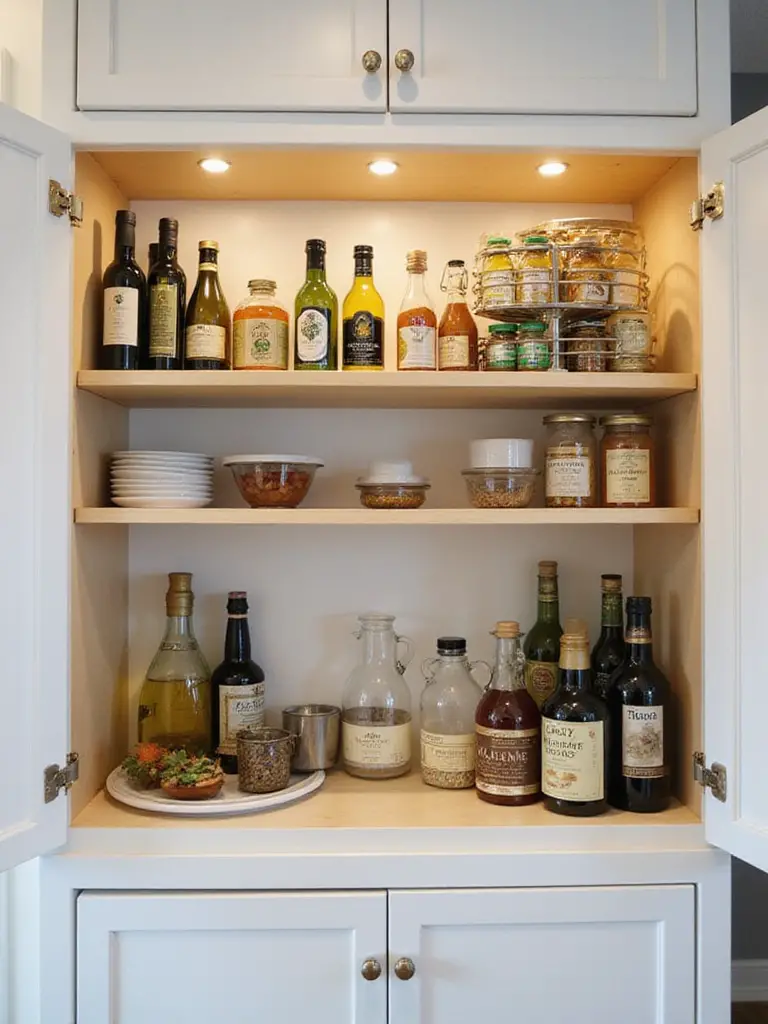
Effective bottle organizers include tiered step shelves that elevate bottles in the back for better visibility, Lazy Susans that bring bottles from the back within reach with a simple spin, and pull-out shelves that allow access to the entire collection at once. These solutions not only improve accessibility but also protect oils and vinegars from light and heat exposure, which can degrade their quality over time.
- Tiered step shelves: Best for cabinets with height clearance
- Lazy Susans: Ideal for deep corner cabinets
- Pull-out shelves: Perfect for base cabinets
The unexpected environmental benefit comes from better inventory management—when you can see what you have, you’re less likely to buy duplicates that might expire before use, reducing food waste and unnecessary consumption.
19. Food Storage Container Lid Organizers
The frustration of searching through a jumbled pile of food storage container lids is universal. These thin, lightweight items resist neat stacking and seem to multiply in the dark corners of cabinets, creating chaos and wasting time during meal prep and cleanup.
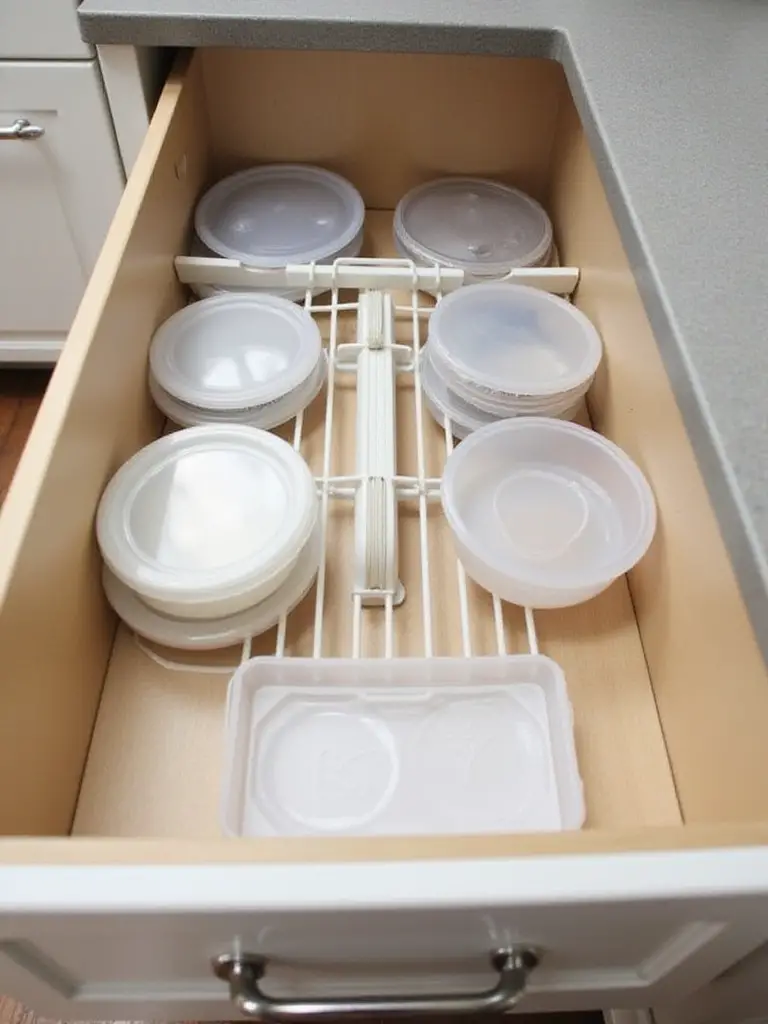
Dedicated lid organizers store these troublesome items vertically in slots or compartments, transforming a messy pile into an orderly system where each lid is visible and accessible. Options include adjustable drawer dividers, specialized racks that sit on shelves, and in-drawer organizers with fixed or adjustable compartments. By containing lids in a compact, organized space, these systems free up significant cabinet real estate for other items.
If you’ve struggled with similar rooms before, you’ll appreciate how these simple organizers can transform not just your storage but your entire relationship with meal preparation and leftovers—suddenly, the prospect of putting away food becomes less daunting when you know exactly where each container and lid belongs.
20. Tiered Corner Shelf Inserts for Cabinets
Corner cabinets, with their deep recesses and awkward angles, often contain significant unused vertical space. Items pushed into these corners become difficult to see and access, effectively disappearing from your usable inventory.
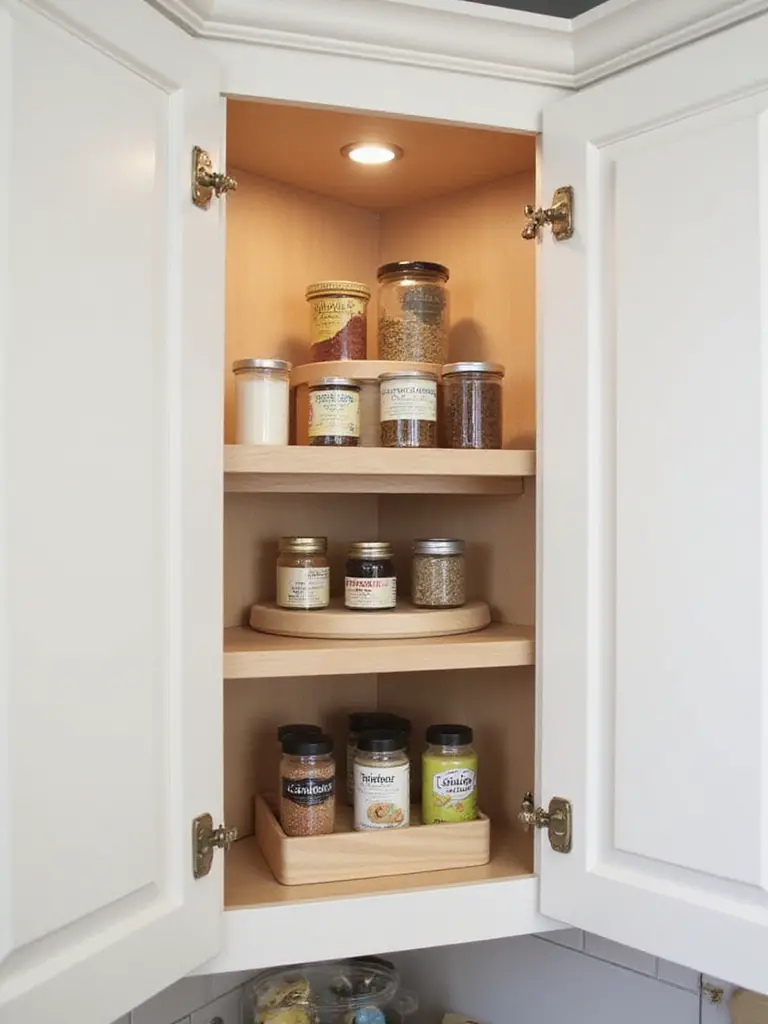
Tiered corner shelf inserts feature multiple levels arranged in triangular or quarter-circle shapes to fit snugly into 90-degree cabinet corners. By lifting items on the back tiers, they improve visibility and accessibility without requiring you to reach deep into the corner or move items in the front. These inserts are ideal for organizing smaller items like spice jars, canned goods, or tea boxes that would otherwise get lost in the depths of corner cabinets.
The design language evolved from traditional patterns that maximize space in compact desert dwellings, where resource conservation extends to spatial efficiency. These kitchen cabinet organizers represent a philosophy that sees constraints not as limitations but as opportunities for creative solutions.
Conclusion: The Desert-Modern Approach to Kitchen Organization
Kitchen cabinet organizers aren’t just accessories—they’re essential tools that transform how we interact with our cooking spaces. Like the desert landscape that inspires my design work, the best organizational systems combine beauty with function, creating order that serves a purpose beyond mere aesthetics.
By implementing even a few of these solutions, you’ll discover space you didn’t know existed, save time during cooking and cleanup, and reduce the daily friction that comes from disorganization. The desert teaches us to value resources—whether water, energy, or space—and these organizers bring that wisdom into the heart of your home. Your kitchen cabinets can become models of efficiency and calm, proving that thoughtful organization isn’t a luxury but a necessity for modern living.
